2018 MERCEDES-BENZ CLA warning
[x] Cancel search: warningPage 65 of 326

The distance warning function may not give
warnings in all critical situations. There is a
risk of an accident.
Always pay careful attention to the traffic sit-
uation and be ready to brake.
Always adapt your speed to suit the prevailing
road and traffic conditions.
G WARNING
The distance warning function cannot always
clearly identify object sa nd complex traffic
situations.
In such cases, the distance warning function
may: R
give an unnecessary warning R
not give aw arning
There is ar isk of an accident.
Always pay careful attention to the traffic sit-
uation and do not rely solely on the distance
warning function.
Function Starting at as peed of approximately 4m ph
(7 km/h), the distance warning function warns
you if you rapidly approach av ehicle in front .A n
intermittent warning ton ew ill then sound, and
the �
Page 66 of 326

sensor technology to assess the traffic situa-
tion.
Situation-dependent braking assistance is capa-
ble of reacting to moving objects that have
alread yb een detected as such at least once
over the period of observation, up to vehicle
speeds of around 155 mph (250 km/h).
Situation-dependent braking assistance can
also detect stationary objects, up to vehicle
speeds of around 44 mph (70 km/h). X
Keep the brake pedal depressed until the
emergency braking situation is over.
ABS prevents the wheels from locking.
The brakes will work normally agai ni f:R
you release the brake pedal. R
there is no longer any danger of ac ollision.R
no obstacle is detected in front of your vehi-
cle.
Situation-dependent braking assistance is then
deactivated.
Important safety notes
i Observe the "Important safety notes" sec-
tion for driving safety systems ( Y
page 61).
G WARNING
Adaptive Brake Assist does not react: R
to people or animals R
to oncoming vehicles R
to crossing traffic R
when cornering
As ar esult, Adaptive Brake Assist may not
intervene in all critical conditions. There is a
risk of an accident.
Always pay careful attention to the traffic sit-
uation and be ready to brake.
G WARNING
Adaptive Brake Assist cannot always clearly
identify objects and complex traffic situa-
tions.
In such cases, Adaptive Brake Assist might: R
intervene unnecessarily R
not intervene
There is ar isk of an accident. Always pay careful attention to the traffic sit-
uation and be ready to brake. Terminate the
intervention in an on-critical driving situation.
Due to the nature of the system, complex but
non-critical driving conditions may also cause
Active Brake Assist to intervene.
Even if Active Brake Assist is not available due to
am alfunction in the radar sensor system, the
brake system is still available with full brake
boosting effect and BAS.
ESP ®
(Electronic Stability Program)
General notes
i Observe the "Important safety notes" sec-
tion ( Y
page 61).
ESP ®
monitors driving stability and traction ,i .e.
power transmission between the tires and the
road surface.
If ESP ®
detects that the vehicle is deviating from
the direction desired by the driver, one or more
wheels are braked to stabilize the vehicle. The
engine output is also modified to keep the vehi-
cle on the desired course within physical limits.
ESP ®
assists the driver when pulling awa yo n
wet or slippery roads. ESP ®
can also stabilize
the vehicle during braking.
ETS/4ETS (Electronic Traction System)
i Observe the "Important safety notes" sec-
tion ( Y
page 61).
ETS traction control is part of ESP ®
.Onv ehicles
with 4MATIC, 4ETS is part of ESP ®
.
Traction control brakes the drive wheels indi-
vidually if they spin. This enables you to pull
awa ya nd accelerate on slippery surfaces, for
example if the road surface is slippery on one
side. In addition, more drive torque is transfer-
red to the wheel or wheels with traction.
Traction control remains active, even if you
deactivate ESP ®
.
Important safety notes
i Observe the "Important safety notes" sec-
tion ( Y
page 61).64
Driving safety systems
Safety
Page 67 of 326
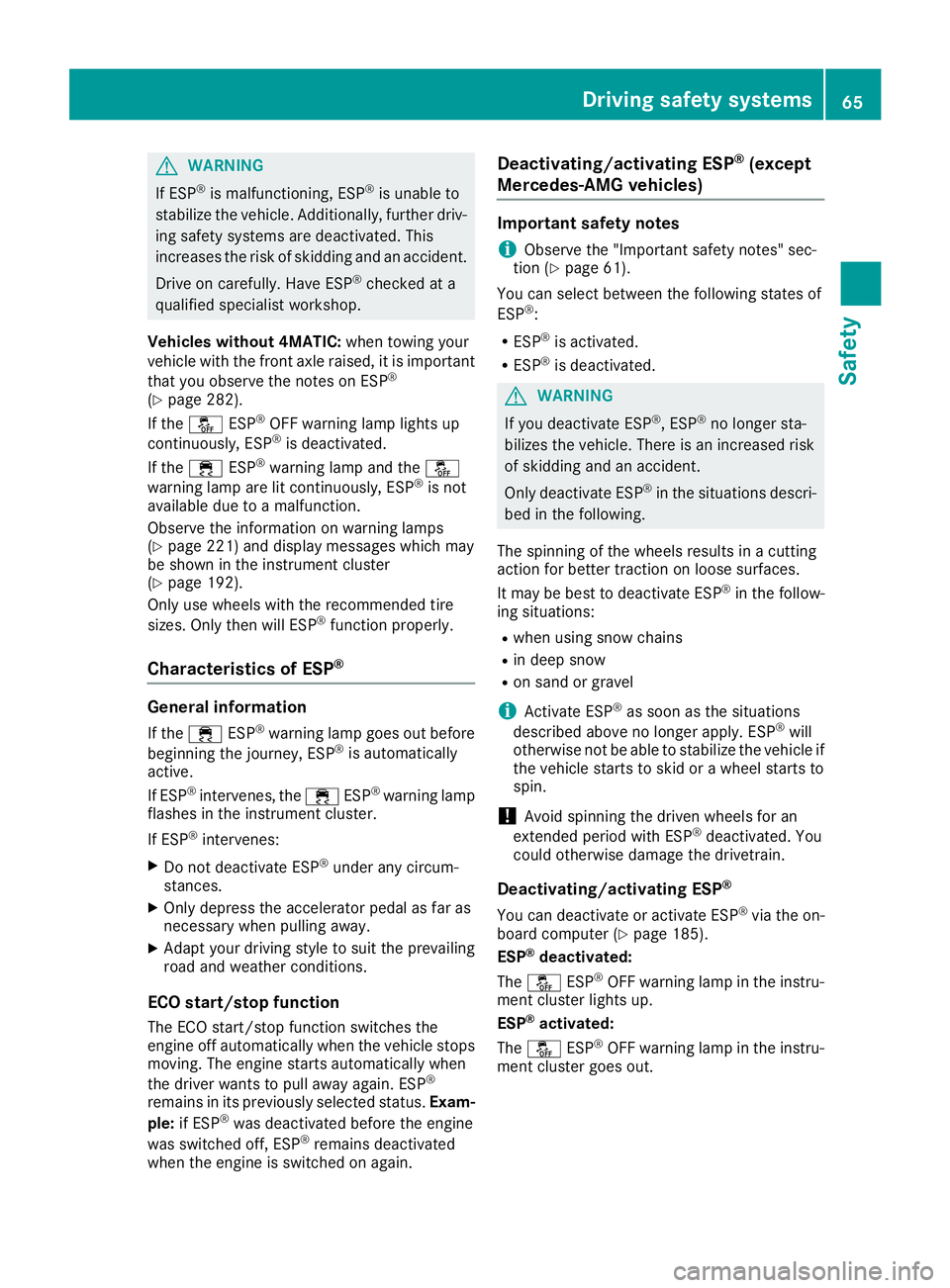
G WARNING
If ESP ®
is malfunctioning, ESP ®
is unable to
stabilize the vehicle. Additionally, further driv-
ing safety systems are deactivated. This
increases the risk of skidding and an accident.
Drive on carefully .H ave ESP ®
checked at a
qualified specialist workshop.
Vehicles without 4MATIC: when towing your
vehicl ew ith the front axle raised, it is important
that you observe the notes on ESP ®
( Y
pag e2 82).
If the �
Page 72 of 326
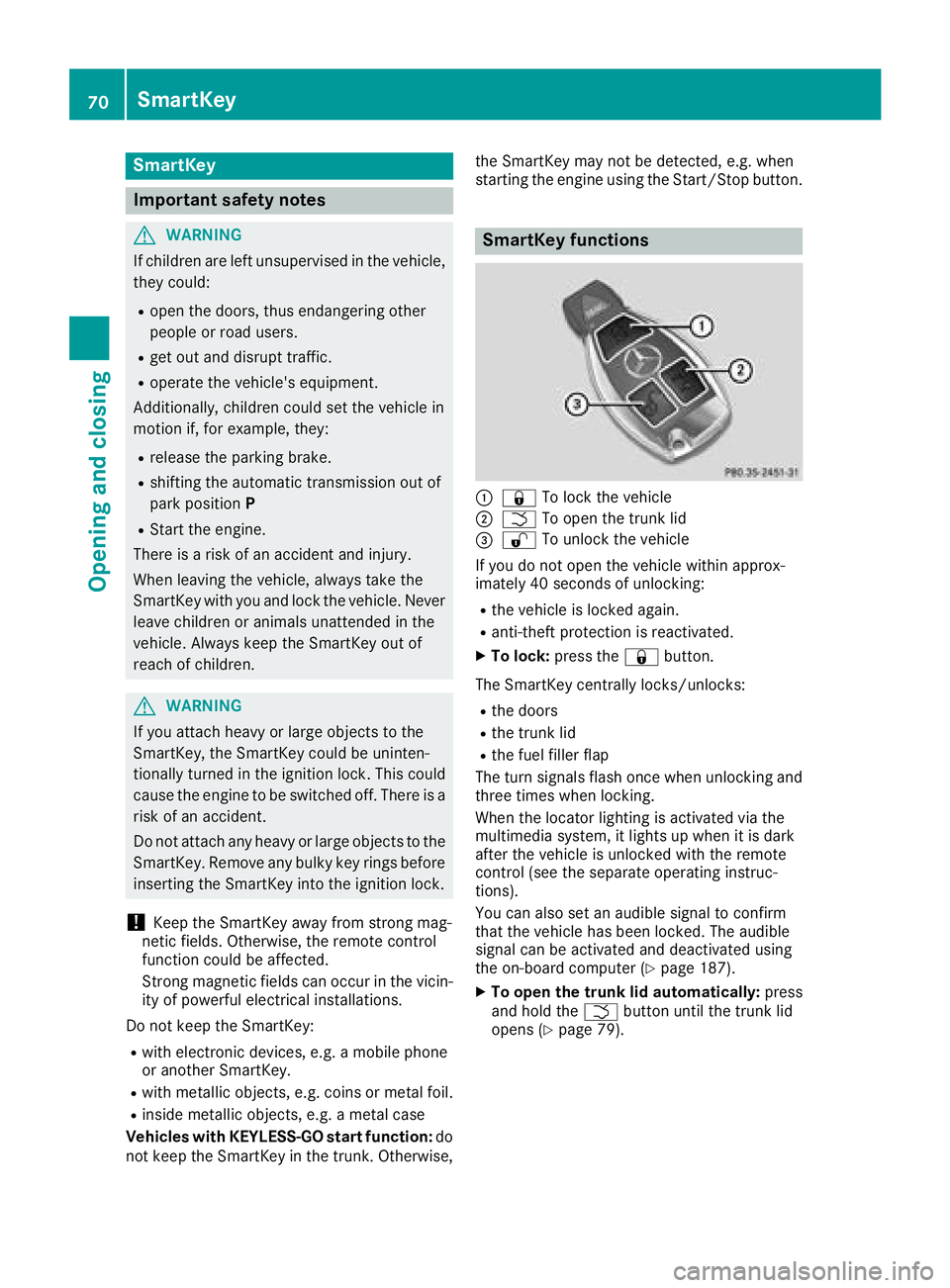
SmartKey
Important safety notes
G WARNING
If children are left unsupervised in the vehicle,
they could: R
open the doors, thus endangering other
people or road users. R
get out and disrupt traffic. R
operate the vehicle's equipment.
Additionally, children could set the vehicle in
motion if, for example, they: R
release the parking brake. R
shifting the automatic transmission out of
park position PR
Start the engine.
There is ar isk of an accident and injury.
When leaving the vehicle, always take the
SmartKey with you and lock the vehicle. Never
leave children or animals unattended in the
vehicle. Always keep the SmartKey out of
reach of children.
G WARNING
If you attach heavy or large object stot he
SmartKey, the SmartKey could be uninten-
tionally turned in the ignition lock. This could
cause the engine to be switched off. There is a
risk of an accident.
Do not attach any heavy or large object stot he
SmartKey. Remove any bulky key rings before
insertin gt he SmartKey into the ignition lock.
! Keep the SmartKey away from stron gm ag-
netic fields. Otherwise, the remote control
function could be affected.
Strong magnetic fields can occur in the vicin-
ity of powerful electrical installations.
Do not keep the SmartKey: R
with electronic devices, e.g. am obile phone
or another SmartKey. R
with metallic objects, e.g. coins or metal foil. R
inside metallic objects, e.g. am etal case
Vehicles with KEYLESS-GO star tf unction: do
not keep the SmartKey in the trunk .O therwise, the SmartKey may not be detected, e.g. when
startin gt he engine using the Start/Stop button.
SmartKey functions
�C
�7 To lock the vehicle�D
�T To open the trunk lid�
Page 75 of 326
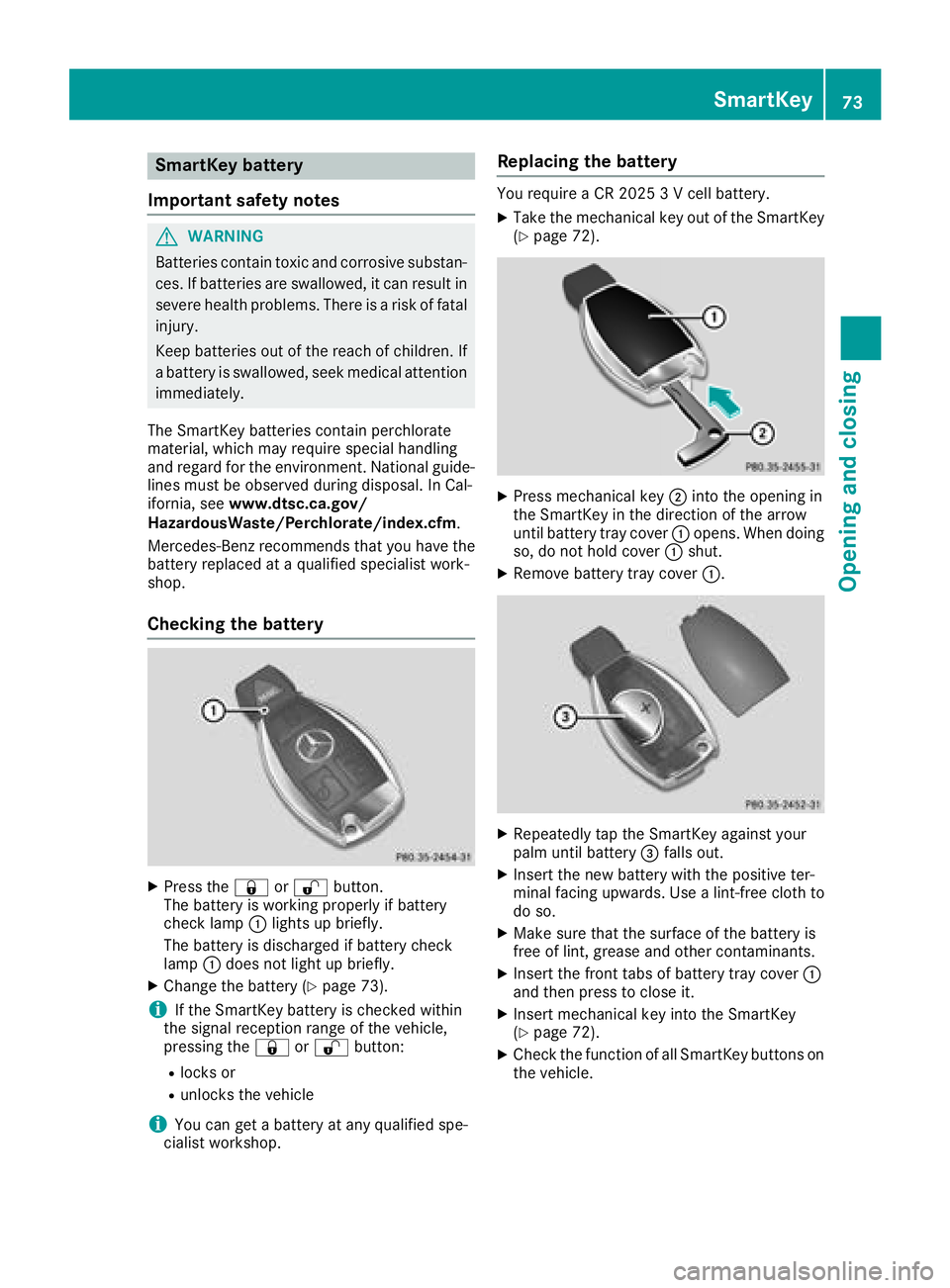
SmartKey battery
Important safety notes
G WARNING
Batteries contain toxic and corrosive substan-
ces. If batteries are swallowed, it can result in
severe health problems. There is ar isk of fatal
injury.
Keep batteries out of the reach of children. If
ab attery is swallowed, seek medical attention
immediately.
The SmartKey batteries contain perchlorate
material, which may require special handling
and regard for the environment. National guide-
lines must be observed during disposal. In Cal-
ifornia, see www.dtsc.ca.gov/
HazardousWaste/Perchlorate/index.cfm .
Mercedes-Benz recommends that you have the
battery replaced at aq ualified specialist work-
shop.
Checking the battery
X
Press the �7 or �6 button.
The battery is working properly if battery
check lamp �C lights up briefly.
The battery is discharged if battery check
lamp �C does not light up briefly.X
Change the battery ( Y
page 73).
i If the SmartKey battery is checked within
the signal reception range of the vehicle,
pressing the �7 or �6 button:R
locks or R
unlocks the vehicle
i You can get ab attery at any qualified spe-
cialist workshop. Replacing the battery You require aCR2 025 3Vc ell battery.X
Take the mechanical key out of the SmartKey
( Y
page 72).
X
Press mechanical key �D into the opening in
the SmartKey in the direction of the arrow
until battery tray cover �C opens. When doing
so, do not hold cover �C shut.X
Remove battery tray cover �C .
X
Repeatedly tap the SmartKey against your
palm until battery �
Page 78 of 326
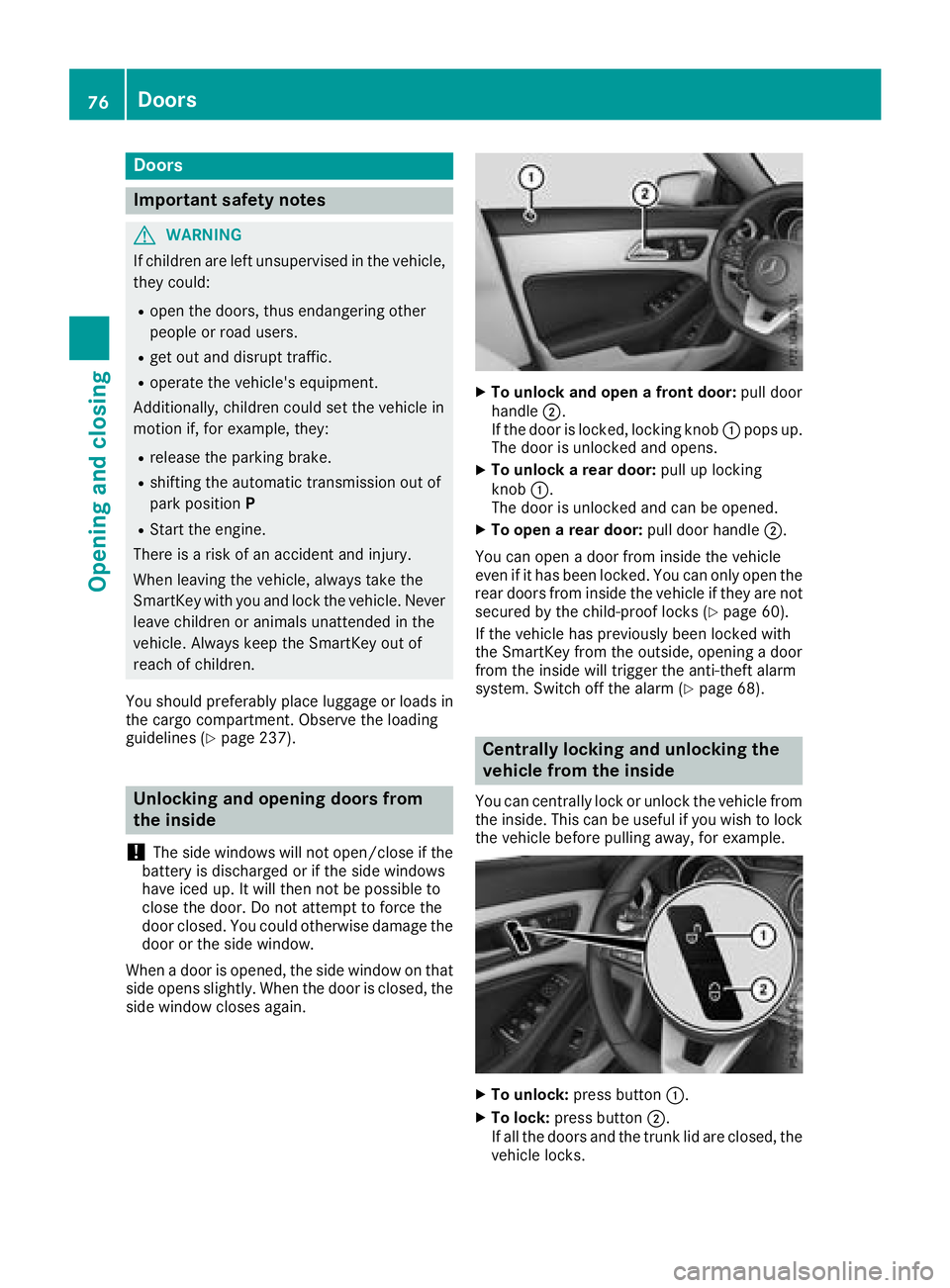
Door s
Important safet yn otes
G WARNING
If children are lef tu nsupervised in th ev ehicle,
they could: R
ope nt he doors ,t hu se nd angerin go th er
people or road users. R
get out and disrup tt ra ffic .R
operat et he vehicle' se quipment.
Additionally, children could set th ev ehicle in
motion if, fo re xa mple, they:R
release th ep arking brake .R
shiftin gt he automatic transmissio no ut of
par kp osition PR
Start th ee ng ine.
There is ar is kofana cciden ta nd injury.
Whe nl eavin gt he vehicle, always take th e
SmartKey wit hy ou and loc kt he vehicle. Never
leav ec hi ldren or animals unattended in th e
vehicle. Always keep th eS ma rtKey out of
reach of children .
You should preferably plac el uggage or load si n
th ec argo compartment. Observ et he loadin g
guidelines ( Y
page 237).
Unlockin ga nd opening doors from
th ei nside
! The sid ew indows will no to pen/close if th e
battery is discharged or if th es id ew indows
hav ei ce du p. It will then no tbep ossible to
close th ed oor. Do no ta ttemp ttof orce th e
doo rc lo sed. You could otherwise damage th e
doo rort he sid ew indow.
Whe nad oo riso pened, th es id ew indow on that
sid eo pens slightly. Whe nt he doo risc lo sed, th e
sid ew indow close sa gain . X
To unlock an do pe naf ro nt door: pull doo r
handle �D .
If th ed oo risl ocked, locking knob �C pop su p.
The doo risu nlocke da nd opens .X
To unlock ar ea rd oor: pull up locking
knob �C .
The doo risu nlocke da nd can be opened.X
To ope nar ea rd oor: pull doo rh andle �D .
You can ope nad oo rf ro mi ns id et he vehicle
eve nifith as bee nl ocked. You can only ope nt he
rea rd oors from insid et he vehicle if they are no t
secure dbyt he child-proof locks ( Y
page 60).
If th ev ehicle has previously bee nl ocke dw it h
th eS ma rtKey from th eo utside, opening ad oo r
from th ei ns id ew ill trigger th ea nti-thef ta lar m
system. Switc ho ff th ea lar m( Y
page 68).
Centrally locking an du nl ocking th e
vehicle from th ei nsideYou can centrall yl oc koru nloc kt he vehicle from
th ei ns ide. Thi sc an be useful if you wish to loc k
th ev ehicle befor ep ulling away, fo re xa mple.
X
To unlock : press butto n �C .X
To lock : press butto n �D .
If all th ed oors and th et ru nk lid are closed, th e
vehicle locks .76
Doors
Opening an dc losing
Page 80 of 326
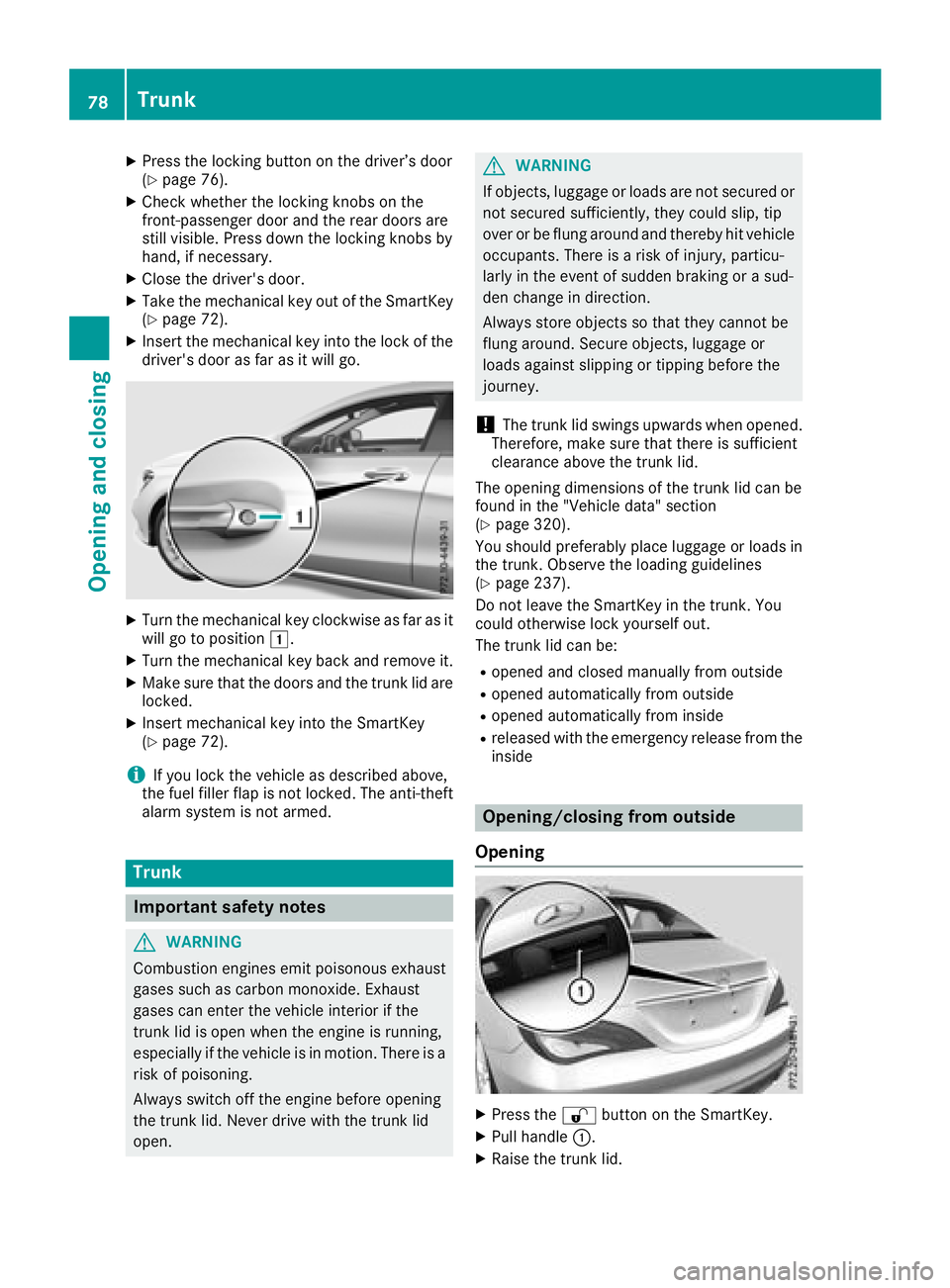
X
Press the lockin gb utton on the driver’s door
( Y
page 76).X
Check whether the lockin gk nobs on the
front-passenger door and the rear doors are
still visible. Press down the lockin gk nobs by
hand, if necessary. X
Close the driver's door. X
Take the mechanical key out of the SmartKey
( Y
page 72).X
Insert the mechanical key into the lock of the
driver's door as far as it will go.
X
Turn the mechanical key clockwise as far as it
will go to position �G .X
Turn the mechanical key back and remove it. X
Make sure that the doors and the trunk lid are
locked. X
Insert mechanical key into the SmartKey
( Y
page 72).
i If you lock the vehicle as described above,
the fuel filler flap is not locked. The anti-theft
alarm system is not armed.
Trunk
Important safety notes
G WARNING
Combustion engines emit poisonous exhaust
gases such as carbon monoxide. Exhaust
gases can enter the vehicle interior if the
trunk lid is open when the engine is running,
especially if the vehicle is in motion .T here is a
risk of poisoning.
Always switch off the engine before opening
the trunk lid. Never drive with the trunk lid
open. G WARNING
If objects, luggage or loads are not secured or
not secured sufficiently, they could slip, tip
over or be flung around and thereby hit vehicle
occupants. There is ar isk of injury, particu-
larly in the event of sudden braking or as ud-
den change in direction.
Always store object ssot hat they cannot be
flung around. Secure objects, luggage or
loads against slipping or tipping before the
journey.
! The trunk lid swings upwards when opened.
Therefore, make sure that there is sufficient
clearance above the trunk lid.
The opening dimensions of the trunk lid can be
found in the "Vehicle data" section
( Y
page 320).
You should preferably place luggage or loads in
the trunk .O bserve the loading guidelines
( Y
page 237).
Do not leave the SmartKey in the trunk .Y ou
could otherwise lock yourself out.
The trunk lid can be: R
opened and closed manually from outside R
opened automatically from outside R
opened automatically from inside R
released with the emergenc yr elease from the
inside
Opening/closing from outside
Opening
X
Press the �6 button on the SmartKey. X
Pull handle �C . X
Raise the trunk lid.78
Trunk
Opening and closing
Page 81 of 326

Closing X
Pull down th et ru nk lid usin gh andle �C .X
Let th et ru nk lid dro pi nt ot he lock.X
If necessary, loc kt he vehicle wit ht he �7
butto nont he SmartKey or wit hK EY LESS-GO.
Opening automatically from outside
Important safety notes
G WARNING
Combustion engines emit poisonous exhaust
gases suc hasc arbon monoxide. Exhaust
gases can ente rt he vehicle interio rift he
trunk lid is open when th ee ng in eisr unning,
especiall yift he vehicle is in motion .T her eisa
ris kofp oisoning.
Always switch off th ee ng in eb efore opening
th et ru nk lid. Never driv ew it ht he trunk lid
open.
! The trunk lid swings upward sw hen opened.
Therefore, mak es ure that there is sufficient
clearance abov et he trunk lid.
i The opening dimension soft he trunk lid can
be foun du nde r" Vehicle data" ( Y
page 320).
Opening automatically
You can open th et ru nk lid automaticall yu sing
th eS ma rtKey or th eh andle in th et ru nk lid.X
Press and hold the �T butto nont he Smart-
Key until th et ru nk lid opens.
or X
If th et ru nk lid is unlocked, pull th et ru nk lid
handle and let it go again immediately. HANDS-FREE ACCESS
Important safety notes
G WARNING
The vehicle's exhaust system may be ver yh ot.
You coul db urn yourself by touching the
exhaust system if you use HANDS-FREE
ACCESS .T her eisar is kofi njury. Always
ensure that you only mak et he kickin gm ove-
men tw ithin th ed etection range of sensors.
! If th eS ma rtKey is within th er ear detection
range of KEYLESS-GO ,t he followin gs itua-
tions ,f or example ,c oul dl ead to th eu ninten-
tional opening of th et ru nk:R
usin gac ar wash R
usin gap ower washer
Mak es ure that th eS ma rtKey is at least 10 ft
(3 m) away from th ev ehicle.
i You can also deactivate KEYLESS-GO .F ur-
ther informatio nond eactivatin ga nd activat-
ing KEYLESS-GO ( Y
page 71).
General notes Wit hK EY LESS-GO and HANDS-FRE EA CCESS,
you can open th et ru nk lid without usin gy our
hands. This is useful if you have your hands full.
To do this, mak eak ickin gm ovement unde rt he
bumpe rw it hy our foot.
Observ et he followin gp oints:R
Carr yy our KEYLESS-GO ke ya bout your per-
son .T he KEYLESS-GO ke ym ust be in th er ear
detection range of th ev ehicle.R
When making th ek ickin gm ovement ,m ake
sure that you are standing firmly on the
ground and that there is sufficient clearance
to th er ear of th ev ehicle .Y ou coul do th erwise
lose your balance, for example on ice. Trunk 79
Opening and closing Z